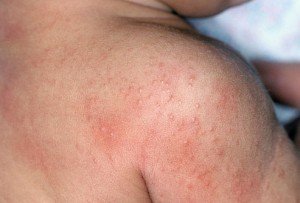Heat rashes occur to due exposure to heat or hot environments and usually cause itchy, red rashes on the skin. Heat rash occurs as a result of dead skin cells that block the sweat glands. This causes sweat to accumulate in the gland, beneath the skin. The build-up of sweat causes the sweat glands to enlarge and swell, thus causing a skin rash.
Disclaimer: the material posted in this article is for information purposes only. Learn first aid and CPR techniques by taking workplace approved first aid training.
Signs and symptoms
Signs and symptoms of heat rash include:
- Red rash. Rash looks like small bumps on the skin which usually occurs in regions of the skin that is covered with clothing
- Itching – the rash may give a prickly feeling
- Warm, dry skin
When to seek medical attention
See your doctor as son a possible if any of the symptoms result along with the rash:
- Fever
- Skin swelling
- Painful rash
- Persistent vomiting
- Worsening rash
- Skin tenderness
Evaluation
For physical evaluation, two physical findings may indicate the presence of rash:
- Tiny blisters on the skin
- Tiny bumps that are red
Diagnosis for heat rash depends on physical examination in which the symptoms are discovered; therefore tests are not required to determine the presence of heat rash.
Treatment
Heat rashes can be uncomfortable, but they are usually non-serious conditions that can be treated at home.
It is important that you see your doctor if any of the problems result from the rash:
- Rash gets worse
- Heat rash is persistent and stays for more than 3 days
- Heat rash is tender and red
- Heat rash oozes out pus
- Heat rash swells
Follow these steps if your child is suffering from a heat rash:
1. Treat symptoms of the rash
- Bathe your child in cool water
- Allow your child sit or rest in an air-conditioned room or near a fan so that the cool breeze flows to him
- Avoid applying antibiotic creams or ointments as they might irritate the skin and worsen the condition
2. Keep your child cool
- Make him or her wear loose fitting, light clothes for summer. Cotton fabrics are good for the heat as they absorb moisture
3. Make sure your child is well-hydrated
- Give your child plenty of cool fluids such as juices and water especially during hot weathers
Home care for heat rash and prevention
The following home care tips will help you treat heat rash at home:
- Take regular tepid water baths
- Wear dry clothes and change your clothes every time they get wet
- Avoid sun exposure by wearing a hat, or wearing clothing that may block sunlight such as long-sleeve clothes
- Do not use moisturizing lotions
- Stay away from warm environments as much as possible
The following preventative tips will reduce the chances f developing a heat rash:
- Wear loose fitting, light weight cotton clothes in hot weathers
- Keep your clothes dry
- Avoid applying moisturizing lotions of the skin
- Avoid the sun
- Take cool baths
- Stay in air conditioned environments
- Change your clothes if soaked in sweat
- Do not take hot baths, whenever possible
Learn More
To learn more about heat related emergencies such as heat rashes and fevers enrol in workplace approved first aid training (sign up here).
Related Video

